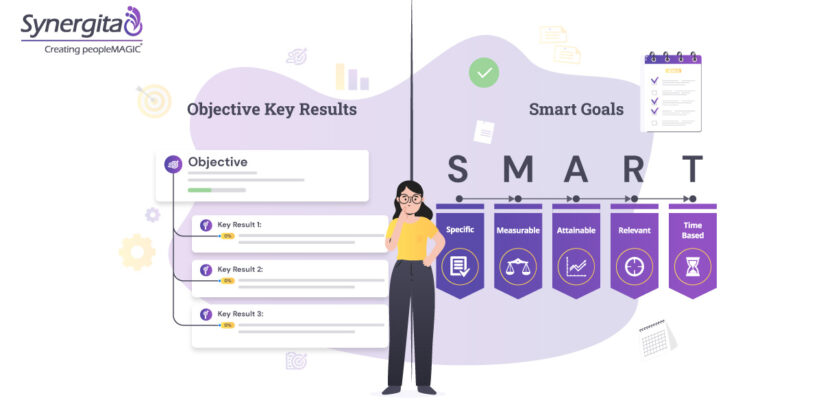Are OKRs and SMART Goals the same?
Businesses, irrespective of size, should have a clear vision and direction toward achieving the set overall objective. There are many popular approaches; one popular approach is to use goal-setting frameworks such as Objectives and Key Results (OKRs) and Specific, Measurable, Achievable, Relevant, and Time-bound (SMART) goals. In this blog post, we will explore the similarities and differences between OKRs and SMART goals and when to use each of them to help CEOs, market leaders, managers, and department heads guide their organizations toward success. It can be the ultimate OKR guide for the market leaders out there.
What are OKRs and SMART Goals?
OKR stands for Objectives and Key Results. It is a goal-setting framework that was developed by Intel and has been adopted by many other organizations, including Google, LinkedIn, and Twitter, among others. This framework aids teams and individuals in setting ambitious and measurable goals that align with the organization’s overall strategy and mission.
Here are some key points about OKRs:
- OKRs are a goal-setting framework that defines specific, measurable objectives and the key results that will be used to track progress towards achieving those objectives.
- Objectives are the specific goals that an individual, team, or organization wants to achieve within a given timeframe. They should be ambitious, specific, and aligned with the overall strategy.
- Key results are the metrics or milestones that will be used to measure progress towards achieving the objectives. Key results should be specific, measurable, and actionable.
- OKRs are typically set on a quarterly basis, although some organizations may set them on a different timeframe.
- OKRs are designed to be transparent and collaborative, so that everyone in the organization can see what everyone else is working on and how they are contributing to the overall goals of the organization.
- OKRs should be reviewed and updated regularly to ensure that progress is being made towards the objectives and key results, and to make any necessary adjustments to the plan.
- OKRs can be used at all levels of an organization, from individual contributors to teams to entire departments and even the entire organization.
SMART goals are specific, measurable, achievable, relevant, and time-bound objectives that can help individuals and organizations achieve their desired outcomes. They provide a framework for setting objectives that are specific, measurable, achievable, relevant, and time bound. By using this approach, individuals and organizations can increase their chances of success and achieve their desired outcomes more effectively.
Here are some bulleted points explaining what SMART goals are and how they can be used:
- SMART goals are specific, meaning they are well-defined and clear. They are not vague or ambiguous, but rather focus on a particular outcome or result.
- SMART goals are measurable, meaning they can be quantified or assessed using specific criteria or metrics. This allows progress to be tracked and evaluated.
- SMART goals are achievable, meaning they are realistic and can be accomplished with the resources and time available. They should not be overly ambitious or impossible to attain.
- SMART goals are relevant, meaning they align with an individual’s or organization’s broader objectives or priorities. They should be meaningful and valuable to the person or group setting them.
- SMART goals are time-bound, meaning they have a specific deadline or timeframe associated with them. This helps to create a sense of urgency and motivation to achieve the goal.

Similarities between OKRs and SMART Goals
There are several similarities between OKR (Objectives and Key Results) and SMART goals, which are described below:
- Specificity: Both OKRs and SMART goals require specific and well-defined targets. OKRs have objectives that describe a specific outcome, while SMART goals require a clear and specific goal statement.
- Measurability: Both approaches require goals to be measurable. OKRs have Key Results that provide measurable evidence of progress towards the objective, while SMART goals require a way to measure progress towards the goal.
- Achievability: Both OKRs and SMART goals require goals to be achievable. OKRs encourage setting ambitious yet achievable goals, while SMART goals require goals to be realistic and attainable.
- Relevance: Both approaches require goals to be relevant to the overall vision and strategy. OKRs ensure alignment with the company’s overall strategy by setting objectives that support it, while SMART goals require goals to align with the larger goal of the organization.
- Time-bound: Both OKRs and SMART goals require goals to be time-bound. OKRs have a specific time frame, typically quarterly or annually, for achieving the Objective and Key Results, while SMART goals have a specific deadline or time frame for achieving the goal.
- Feedback and Accountability: Both approaches require regular check-ins and progress reviews to ensure accountability and provide feedback. OKRs encourage regular check-ins and updates to Key Results to track progress, while SMART goals require regular feedback and progress reports to ensure the goal is on track.
Differences between OKRs and SMART Goals
OKR and SMART goals are both goal-setting frameworks. While they share some similarities, they differ in their approach to goal setting. Here are the differences between OKR and SMART goals:
Focus- OKRs focus on setting ambitious and aspirational objectives and then breaking them down into key results.
- SMART goals focus on setting specific, measurable, achievable, relevant, and time-bound goals.
Purpose
- OKR is used for aligning the entire organization toward a common goal.
- SMART goals are primarily used for setting individual goals, performance management, and project management.
Flexibility
- OKR allows for flexibility in the key results to achieve the objective, as long as they are aligned with the overall objective.
- SMART goals are relatively inflexible and may not adapt to changing circumstances.
Timeframe
- OKR aims for a longer-term horizon, usually a year or more.
- SMART goals are typically set for the short-term (weeks, months, or quarters).
Metrics
- OKR uses measurable key results to track progress towards the objective.
- SMART goals typically have specific metrics associated with them to track progress.
Structure
- OKR has a flexible and less structured format that allows for creativity in setting objectives and key results.
- SMART goals have a clear and structured format that outlines the specific goal, metrics, and time frame.
Implementation
- OKR is implemented across the entire organization, from top-level executives to individual contributors.
- SMART goals are often used in performance reviews and one-on-one meetings between employees and their managers.

When to use OKR and SMART Goals?
The choice between OKRs and SMART Goals depends on the specific needs and context of the individual or organization. OKRs are more suitable for organizations that prioritize innovation and collaboration, while SMART Goals are more appropriate for individuals or teams with clear tasks and deadlines.
OKRs are needed:
- for organizations that prioritize rapid growth and innovation.
- for teams that work collaboratively and need to align their goals.
- when there is a need for flexibility and adaptability in goal setting.
- when the focus is on outcomes rather than tasks.
- when there is a need for continuous progress tracking and adjustment.
SMART Goals are needed:
- for individuals or teams with a clear understanding of what needs to be accomplished.
- when goals need to be specific and measurable.
- when there is a need for clear deadlines and milestones.
- when the focus is on completing tasks rather than achieving outcomes.
- when there is a need for accountability and tracking progress.
Conclusion
In conclusion, the best framework for goal setting depends on the context and goals of the individual or organization. As John Doerr, the creator of OKRs, once said, “OKRs are not a silver bullet, but they can help you focus on the things that matter most and achieve incredible results.” Similarly, SMART goals are an effective tool for driving success in personal and business contexts. Ultimately, the key is to use a framework that works for your specific needs and goals.
